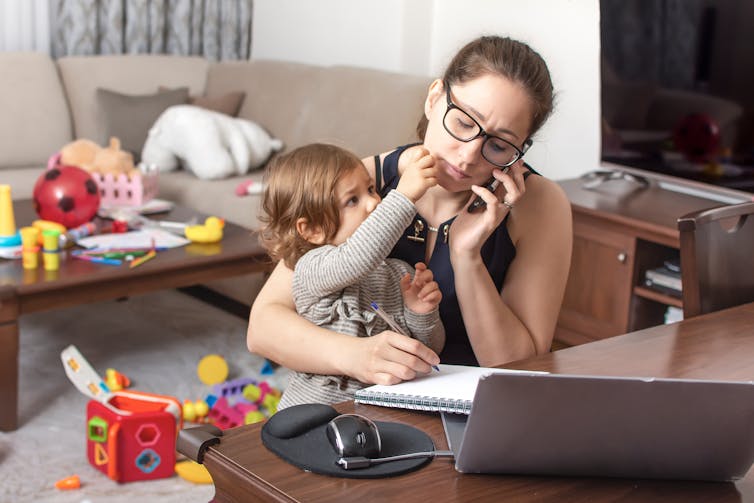Source: The Conversation (Au and NZ) – By Joo-Cheong Tham, Professor, Melbourne Law School, The University of Melbourne

Shutterstock
Before the pandemic, working from home was a luxury. Then it became a necessity. Since lockdowns have eased it has become a contested space between what employers and workers want.
Now unions – including the Financial Services Union, National Tertiary Education Union (of which I am a national councillor) and the Media, Entertainment and Arts Alliance – are pushing to enshrine working from home as a right.
What does it mean to have a right to work from home, and why should there be one? And what conditions are needed to make such a right effective?
What is the current situation?
One way to make working from home a legal entitlement for all would be to change the National Employment Standards, which provide a safety net for all workers, whether they are on an award, enterprise agreement or individual contract.
The standards give workers the right to request flexible working arrangements but only in certain circumstances – if they have caring responsibilities, a disability, are older than 55, or are experiencing domestic violence.
Employers can only refuse these requests on “reasonable business grounds” such as costliness, impracticability and negative impact on productivity and customer service. This leaves a lot of room to reasonably reject a request.
A right through collective agreements
The unions are taking the easier step of securing these rights for their members through collective bargaining – inserting clauses into the enterprise agreements that set pay and conditions above the safety net.

Shutterstock
What those clauses would say is indicated by the Australian Council of Trade Unions’ Working from Home Charter, which states:
Working from home should be offered to all suitable workers to accept on a voluntary basis.
The Financial Sector Union’s “best-practice” guide similarly advocates that:
Employees should be able to enter into and out of work from home arrangements based on their personal circumstances, responsibilities and preferences.
Employers will still be able to refuse requests, but only with good reason. The clauses being sought by the National Tertiary Education Union, for example, will limit refusals to situations when requests cannot be accommodated.
In short, a right to work from home will place the onus on employers to justify why they are seeking to deny working from home arrangements.
Why should there be such a right?
The case for a right to work from home has been made by the seismic shift resulting from the pandemic.
It has shown that, in many instances, work can be performed effectively while working from home. Contrary to managerial concerns that productivity would suffer, research suggests those working from home have higher productivity.
Most workers and many businesses have embraced the change. There is a clear benefit to workers in reduced commuting time and costs (especially for those with long commutes).
Read more:
Even Google agrees there’s no going back to the old office life
There are also social benefits
Working from home may be “the biggest productivity increase of the century”. It helps reduce greenhouse gas emissions – which is why it is part of “green bargaining” for European trade unions. It can also promote a more gender-balanced workforce, as the Productivity Commission’s research suggests:
More women than men are in jobs that can be done remotely. Additionally, since women in Australia still carry most of the responsibility for raising children, and are also more likely than men to care for others, the option to work from home may allow them to access employment.

Shutterstock
More generally, the Productivity Commission expects that reducing “cost” of working will increase the labour supply.
Health is still an imperative
With the COVID-19 pandemic not yet over, there are also powerful safety rationales.
Paul Kelly, the federal chief medical officer, has called working from home “an important health and safety measure”.
As an essential control measure for workplace safety – required in certain situations under work, health and safety legislation – it can even be an act of social solidarity.
5 crucial safeguards to manage risks
Working from home is not without risks.
It may undermine workplace community, and the collaboration and innovation generated from “serendipitous interaction”. But this is less an argument against a right to work from home and more one to wisely manage.
Equally the risks to individual workers need to be managed.
To be effective, a right to work from home should be underpinned by provisions to safeguard five things:
-
Genuine choice. This including the ability to exercise the right to work from home as a group and through trade unions.
-
Working hours. There is a serious risk of “time theft” as the line between work and home life is blurred. (The “reasonable limitation of working hours” is a human right.)
-
Workplace safety. Employers still have work, health and safety obligations to employees working from home.
-
Digital safety. This includes data privacy protection and a right to disconnect outside set working hours.
-
Equity. This includes ensuring working from home does not exacerbate the double burden of paid work and care and distributing costs fairly. The general rule should be that employers provide work equipment and cover necessary costs such as electricity.
Working from home is fundamentally changing where and how we work. A right to work from home with robust support will steer this transformation in a positive direction.
Read more:
Working from home: what are your employer’s responsibilities, and what are yours?
![]()
Joo-Cheong Tham has received funding from the Australian Research Council, the Australian Council of Trade Unions, European Trade Union Institute and International IDEA. He is a director of the Centre for Public Integrity; a national councillor and Victorian division assistant secretary (academic staff)-elect of the National Tertiary Education Union.
– ref. Few Australians have the right to work from home, even after COVID. Here’s how that could change – https://theconversation.com/few-australians-have-the-right-to-work-from-home-even-after-covid-heres-how-that-could-change-187696








